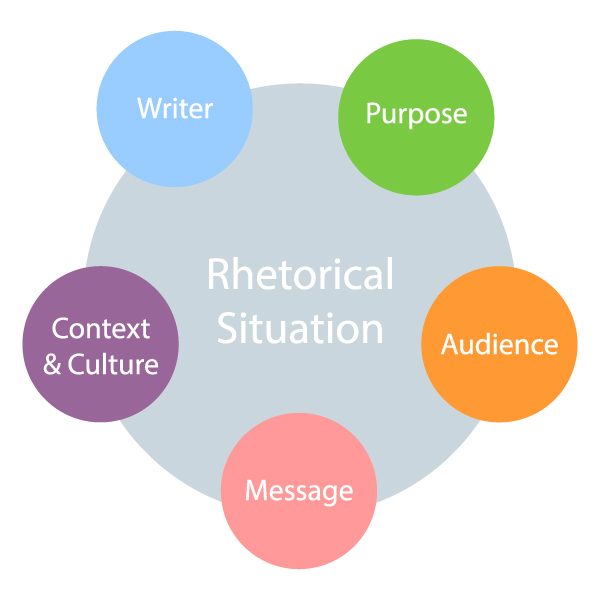What is a rhetorical situation? How does it work? We’ve all heard of things being “rhetorical,” although do we completely understand them? Learn more about a rhetorical situation in this short guide.
What is a rhetorical situation?
A piece of writing or a speech is influenced by its creator’s background, beliefs, interests, and values. Readers interpret the text or speech by considering the circumstances out of which it arises.
The rhetorical situation offers an understanding of how readers and writers relate to each other through the written or spoken medium. It helps writers produce more effective text that meets its intended goals. It allows readers to determine the context in which the writing took place and what the text aims to do.
Let’s look at the rhetorical situation in more detail and use examples for a better grasp of the model.

How do you find the rhetorical situation?
The rhetorical situation is made up of components that impact the development and reception of the text. The components are:
1. Author
2. Exigence
3. Audience
4. Purpose
5. Setting
6. Text
Author
The author is the individual who creates the text. Readers of the text will consider the author’s authority or experience in the subject on which he/she has written. They will also look at the values the author holds with regard to the subject, and factors that affect the author’s perspectives on the subject.
Exigence
The exigence describes the urgent need that the author wants to address through the text. The author knows why he/she wants to express certain points and how those points will impact his/her audience.
Audience
The audience refers to the people the text aims to persuade, inform, or entertain. Individuals other than the intended recipients of the text are also included in the text’s audience.
Purpose
The purpose describes the aims of the text. Does the writer aim to inform, persuade, or entertain his/her audience? Readers that engage with the text think about the writer’s motivations to create the text and the goals of that text.
Context
The context is made up of all the factors that influence the meaning of the text. The types of context are:
Physical context
The physical settings of authors affect the texts they create. For example, some writers may find they’re able to produce more effective text in bustling coffee shops while others may prefer the solitude of libraries. The specific places in which readers receive the text affect how they respond to the text.
For example, those commuting by train may read a pamphlet in a more leisurely way, which will affect how they feel about its contents. If the same pamphlet were to be handed to them while they were walking, they may engage with it differently.
Social context
The social environment of writers and readers affects how they create and receive a text. Writers and readers belonging to similar communities are more likely to communicate effectively with one another compared to writers or readers belonging to different communities.
Writers may not need to provide a detailed background on a topic when presenting to groups already familiar with the topic. Supporters of a political party will not expect a columnist supporting the rival party to provide a nuanced or unbiased account of a key poll issue.
Cultural context
A documentary set in the sixties will connect more easily with viewers who are intimately familiar with the social behaviors and speech of that era. Millennials may find it hard to understand the colloquial speech and slang of earlier generations.
Readers based in India may find it easier to follow a news article on the issue of dowry deaths than counterparts in the west, where the dowry system has never existed.
Topic
The topic is the piece of communication, whether that occurs verbally or in writing.

What is an example of a rhetorical situation?
You’re surrounded by rhetoric. It’s in YouTube videos, newspaper ads, television commercials, billboards, political speeches, literary essays, songs, and graphic novels, to name some.
The examples below highlight the components of the rhetorical situation.
1. Archbishop of Canterbury Justin Welby delivered the funeral eulogy for Queen Elizabeth II.
- The exigence is that it is customary to publicly reflect on a Head of State’s life and achievements
- The audience comprises the British public and people from all over the world
- The purpose is to highlight the Queen’s life of public service
- In the west, it is customary to conduct a eulogy to pay tribute to someone who has died
- The topic is the sermon the archbishop delivered at the Queen’s funeral at Westminster Abbey
2. Inaugural address by President Joseph Biden.
- The exigence is that it is customary for the elected President of the United States to deliver an inaugural address
- The audience is Americans although the inaugural address is shown on all international news channels
- The purpose is to share the President’s vision for America and promise to the American people
- The inaugural address is part of the customary ceremony to mark the commencement of a new four-year term of the President of the United States.
- The topic is the inaugural speech by the President.
Use rhetorical analysis to shape messages and gain a detailed understanding of content
Breaking down the rhetorical situation is helpful for writers, speakers, and content creators. A rhetorical analysis of content is useful to identify the improvements needed to make it more appealing to its audience and meet its goals. As a reader, rhetorical analysis is a tool to effectively understand, critique, or enjoy different types of content. Use this model today to enhance your writing and interpretation skills.
Inside this article
Fact checked:
Content is rigorously reviewed by a team of qualified and experienced fact checkers. Fact checkers review articles for factual accuracy, relevance, and timeliness. Learn more.
Core lessons
Glossary
- Abstract Noun
- Accusative Case
- Anecdote
- Antonym
- Active Sentence
- Adverb
- Adjective
- Allegory
- Alliteration
- Adjective Clause
- Adjective Phrase
- Ampersand
- Anastrophe
- Adverbial Clause
- Appositive Phrase
- Clause
- Compound Adjective
- Complex Sentence
- Compound Words
- Compound Predicate
- Common Noun
- Comparative Adjective
- Comparative and Superlative
- Compound Noun
- Compound Subject
- Compound Sentence
- Copular Verb
- Collective Noun
- Colloquialism
- Conciseness
- Consonance
- Conditional
- Concrete Noun
- Conjunction
- Conjugation
- Conditional Sentence
- Comma Splice
- Correlative Conjunction
- Coordinating Conjunction
- Coordinate Adjective
- Cumulative Adjective
- Dative Case
- Determiner
- Declarative Sentence
- Declarative Statement
- Direct Object Pronoun
- Direct Object
- Diction
- Diphthong
- Dangling Modifier
- Demonstrative Pronoun
- Demonstrative Adjective
- Direct Characterization
- Definite Article
- Doublespeak
- False Dilemma Fallacy
- Future Perfect Progressive
- Future Simple
- Future Perfect Continuous
- Future Perfect
- First Conditional
- Irregular Adjective
- Irregular Verb
- Imperative Sentence
- Indefinite Article
- Intransitive Verb
- Introductory Phrase
- Indefinite Pronoun
- Indirect Characterization
- Interrogative Sentence
- Intensive Pronoun
- Inanimate Object
- Indefinite Tense
- Infinitive Phrase
- Interjection
- Intensifier
- Infinitive
- Indicative Mood
- Participle
- Parallelism
- Prepositional Phrase
- Past Simple Tense
- Past Continuous Tense
- Past Perfect Tense
- Past Progressive Tense
- Present Simple Tense
- Present Perfect Tense
- Personal Pronoun
- Personification
- Persuasive Writing
- Parallel Structure
- Phrasal Verb
- Predicate Adjective
- Predicate Nominative
- Phonetic Language
- Plural Noun
- Punctuation
- Punctuation Marks
- Preposition
- Preposition of Place
- Parts of Speech
- Possessive Adjective
- Possessive Determiner
- Possessive Case
- Possessive Noun
- Proper Adjective
- Proper Noun
- Present Participle
- Prefix
- Predicate



